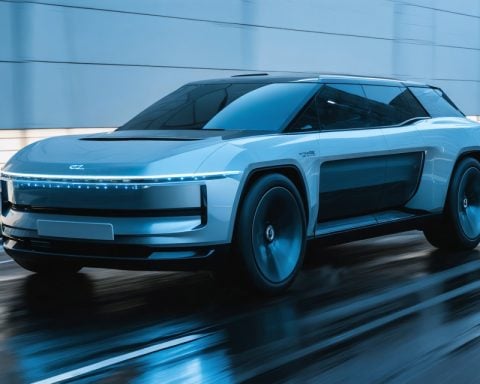- Tesla’s stock dropped 8%, causing its valuation to fall below $1 trillion, reflecting CEO Elon Musk’s warning of a significant downturn.
- The decline is primarily linked to reduced earnings expectations and a sharp drop in European sales, nearly 50% down.
- Tesla’s price-to-earnings ratio of 150 contrasts sharply with traditional automakers like Toyota, which stands at 7.
- The launch of Tesla’s Full Self-Driving update in China offers potential future revenue but has received mixed reviews.
- Shareholders remain hopeful for future growth through innovations like the robotaxi project in Austin.
- Tesla faces the challenge of maintaining its high valuation while addressing the reality of reduced deliveries and earning expectations.
The electric buzz surrounding Tesla dimmed today as its stock tumbled 8%, causing the automaker’s valuation to sink beneath the $1 trillion mark. This echoes CEO Elon Musk’s dramatic prediction, where he vividly likened the potential stock plummet to a soufflé meeting a sledgehammer.
Despite whispers in financial circles linking this downturn to dwindling European sales, analysts have known for weeks that numbers were down by nearly 50%. What seems to be truly shaking Tesla is the mounting anticipation of diminished earnings expectations. With this fresh dip, Tesla’s price-to-earnings ratio hovers around 150—still a far cry from traditional automakers like Toyota, sitting comfortably at a P/E of 7.
Today also saw a silver lining with the introduction of Tesla’s Full Self-Driving update in China, hinting at future revenue recognition. Yet, this launch was met with mixed reviews, reflecting the challenge of balancing market innovation with financial performance.
Many are watching closely as Tesla skates the thin ice of high valuation amid dwindling deliveries. Shareholders pin their hopes on future developments, such as the anticipated robotaxi launch in Austin. But the looming question remains—will these initiatives act as life-rafts or merely push the goalposts further?
This market drama underscores a compelling takeaway: for Tesla to anchor its starstruck valuation, it must navigate the harsh waters of reduced earnings without losing sight of its ground-breaking ambitions. Until then, the backdrop of a stock market adjusting to reality leaves Tesla on an unpredictable trajectory, demanding the automaker recalibrate its strategies and inspire confidence anew.
The Shocking Truth Behind Tesla’s Tumbling Stock and What’s Next
Revenue Diversification: Tesla’s Real-World Use Cases
Tesla has been on a relentless pursuit to establish itself as more than just an electric vehicle (EV) manufacturer. Beyond cars, Tesla ventures into energy with solar panels and battery storage solutions, which may help buffer earnings fluctuations. For instance, Tesla’s Powerwall and Solar Roofs provide sustainable home energy solutions, potentially attracting green-conscious consumers seeking independence from traditional power grids.
Market Forecasts & Industry Trends
The EV market is poised for substantial growth, with MarketWatch predicting a compound annual growth rate (CAGR) of 22.6% from 2021 to 2030. However, Tesla faces fierce competition from established automakers like Ford and General Motors, who are rapidly expanding their own EV offerings. Additionally, China’s growing domestic EV brands pose a serious threat as they continue to gain market share.
Security & Sustainability
Tesla’s commitment to security is demonstrated through its over-the-air software updates, which continuously enhance vehicle safety features. On the sustainability front, Tesla remains a leader in reducing emissions, with studies showing that EVs have significantly lower lifecycle emissions compared to internal combustion engine vehicles. However, concerns about lithium mining’s environmental impact persist, and Tesla is urged to advance sustainable sourcing practices.
Features, Specs & Pricing
Tesla vehicles are renowned for their cutting-edge technology and performance. Features such as Autopilot, advanced safety systems, and high-speed charging are standard across models. Nevertheless, Tesla’s premium pricing positions its vehicles in the higher-end market. For instance, the Model 3 starts around $40,000, while the Model S can exceed $90,000, limiting accessibility for budget-conscious consumers.
Pros & Cons Overview
Pros:
– Innovative technology and performance
– Robust charging infrastructure
– Strong brand recognition and customer loyalty
Cons:
– High valuation and market volatility
– Increasing competition in the EV sector
– Mixed reviews of Autopilot and Full Self-Driving features
Reviews & Comparisons
When compared to traditional automakers, Tesla excels in software and innovation but faces challenges in scaling production and meeting quality expectations. In contrast, companies like Toyota offer reliability and value-for-money, making them appealing to a different consumer base.
Controversies & Limitations
Tesla’s stock volatility is often attributed to CEO Elon Musk’s unpredictable communication style and ambitious promises. Additionally, the Autopilot system has faced scrutiny from regulators due to safety concerns, emphasizing the need for continuous technological refinement.
Insights & Predictions
Analysts suggest that for Tesla to maintain its valuation, it must diversify revenue streams and enhance production efficiencies. The anticipated launch of Tesla’s robotaxi service could revolutionize mobility, though regulatory hurdles remain a challenge.
Actionable Recommendations
– Invest in Charging Infrastructure: If you own a Tesla, ensure you have access to domestic charging solutions to maximize convenience and charge efficiency.
– Future-Proof Your Investment: Consider Tesla’s long-term growth potential and assess your risk tolerance before investing, given its market volatility.
– Stay Informed: Keep abreast of Tesla’s innovation trajectory and industry trends to make educated decisions on engagement with the brand or its stock.
For more information on Tesla’s journey and future developments, visit the official Tesla website.
As Tesla continues to navigate its stock fluctuations, stakeholders and potential investors must weigh the company’s innovative drive against its financial and operational challenges. With the right strategies, Tesla might just propel itself to greater heights in the electrified future.



















